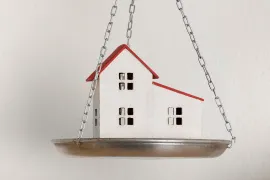This thirty something couple with $390,000 in net worth has decades to save
Far from retirement at what they think might be age 60, they need to include a lot of wiggle room in their financial plan

The challenge and the opportunity with doing financial predictions three decades before retirement is uncertainty. But this couple has a solid foundation to build on.
A couple we’ll call Tyler and Ellie, both 33, live in B.C. Tyler is in construction, Ellie in the grocery industry. Together, they gross $13,000 per month from their jobs before taxes and deductions for benefits. Their net after deductions is $7,268 per month. They have a $650,000 house, $65,700 in financial assets and $360,000 in debts. Their net worth is $390,700. Looking forward, Ellie has just received a promotion and will earn $102,000 per year before tax. They rent out a basement apartment for as much as $1,700 per month or $20,400 per year.
Far from retirement at what they think might be age 60, they are weighing the merits of debt paydown and investing in RRSPs and TFSAs.
Family Finance asked Derek Moran, head of Smarter Financial Planning Ltd. of Kelowna, B.C., to work with Tyler and Ellie. The challenge and the opportunity with doing financial predictions three decades before retirement is, of course, uncertainty. However, he notes, “they have created a strong foundation to build net worth.”
They have $46,000 in Ellie’s RRSP, $10,700 in her TFSA, $9,000 in cash evenly divided and a $350,000 mortgage with a 2.01 per cent interest rate. They have a $10,000 outstanding student loan.
A savings strategy
Their problem is how to save in a tax-efficient manner. Ellie is the main breadwinner. Her monthly income, base $8,580 plus bonuses, averages $9,413.One quick option to save tax would be to move the $10,700 in her TFSA into her RRSP. The investment assets need not change, but she will get a tax refund of 28.2 per cent — the marginal tax bracket in which she falls — times $10,700. That equals $3,017. The savings can be reinvested or used to pay down debt.
We’ll assume she does this, and that they use the RRSP as their primary retirement savings vehicle, due to Ellie’s relatively high income, which will presumably rise with time.
Tyler has a $10,000 outstanding student loan. He is paying six per cent now but could lower that rate to half, three per cent, via a secured Home Equity Line of Credit loan. The student loan is eligible for a tax credit that works out to a one-fifth discount on the interest he is paying, but the HELOC would still be cheaper.
The couple’s RRSPs currently total $46,000. If they roll in the TFSA balance, $10,700, it will become $56,700. Ellie’s new annual income, $102,000, will support RRSP contributions of 18 per cent of her base gross or $18,360. If added to the RRSP and if the sum grows at three per cent above inflation for 27 years to her age 60, it will become $895,800. That sum, spent over the following 30 years to Ellie’s age 90, would support an income of $44,375 in current dollars. We’ll split the income for tax purposes.
We’ll assume that the couple amasses no taxable investments. All money in excess of daily living costs will be saved in RRSPs or used to pay down student loans and the mortgage.
Tyler and Ellie will have to wait for three decades to become eligible for CPP. We’ll assume Ellie qualifies for 90 per cent of CPP benefits, currently $14,445, and thus receives $13,000 per year at 65. We’ll assume that Tyler qualifies for 80 per cent of CPP at 65 and thus receives $11,556 per year.
At age 65, each will qualify for maximum Old Age Security, currently $7,707 per year.
Adding up income from retirement at 60 and assuming splits of eligible income, they would have two RRSP payouts totalling $22,187 each for total income of $44,375 plus $10,200 each rent from an apartment in their basement, total $64,775 before tax. After splits of eligible income and 12 per cent average tax, they would have $4,750 per month to spend. Assuming their present 22-year mortgage is paid off and they have no other debts, their present cost of living, $7,268 per month, and that all RRSP and other savings have ended, their cost of living would drop to $4,253 per month. They would have $500 per month or $6,000 per year to spare.
Retirement
At age 65, they would have two annual RRSP payouts at $22,187 each, $10,200 each rent from their basement apartment, CPP benefits of $13,000 and $11,556 per year, and two OAS benefits of $7,707 each. Their total income would be $89,330. After splits of eligible income and 14 per cent average tax, they would have $6,400 per month to spend. With RRSP and other savings ended and all loans paid, they would have $2,147 per month to spare.This projection of a retirement that might start in three decades is more speculative than definitive. Neither partner has a job pension. One or both might die or become disabled in the 30-year period. It would be helpful for Tyler and Ellie to shop for $500,000 of the simplest term insurance they can find. It could cover outstanding debt and help a survivor until he or she gets back on his or her feet. At their ages, plain term coverage could be had for $242 per year for Tyler and $185 for Ellie.
A thirty-year projection to the start of retirement needs wiggle room. They plan to have children, and Ellie contemplates taking more than a year off work to spend time with the child. That could result in a six-figure income loss — something that would seriously strain their financial plan. It would be better for Tyler, who has a lower income, to stay home with the child so that Ellie can get back to work when possible. Better, Moran suggests, hire a nanny. The nanny could use their basement apartment as part of her compensation. Ellie’s job income and potential promotions would be preserved, Moran suggests.
The unknowns
These projections have some value, even though they are distant and subject to change if tax rates, CPP payouts, OAS payouts and numerous other government tax and benefit programs change. In the best case, with their house paid off and children grown and gone, the couple will be able to achieve our pre- and post-65 income estimates.There are unmentioned and unknown variations in income: Costs of a child or children to be, medical costs not covered by insurance — the list of possibilities is long. We assume that all extra cash will go to Tyler’s RRSP, RESPs for kids, TFSAs and the mortgage.
Retirement stars: 3 *** out of 5
Financial Post
( C) 2022 The Financial Post, Used by Permission

































